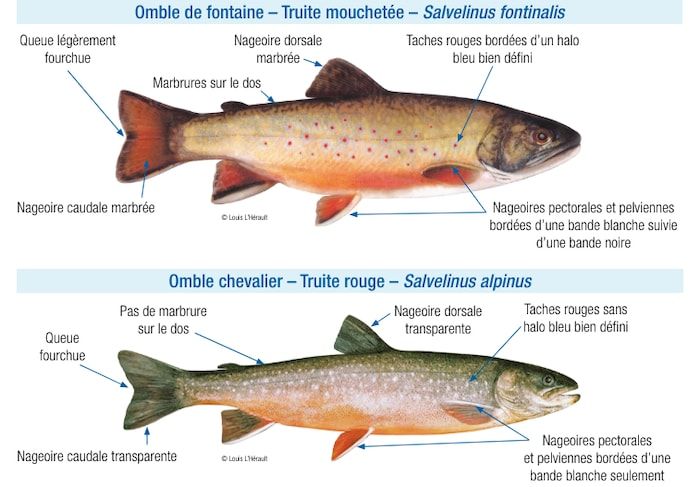Populations of brook trout and arctic char oquassa, commonly called speckled trout and red trout, are overexploited in the greater Quebec region, including in the Laurentides wildlife reserve. The situation is forcing the Ministry of the Environment to lower harvest quotas this year.
The opening of fishing for these two species is scheduled for this Friday in zone 27, which covers the entire greater Quebec region and beyond, from Portneuf in the west to the Saguenay River in the East.
From now on, the daily and possession limit of these fish will be 10 in total by the same person with a valid fishing license. This is a total limit for both species combined. Of the number, only two arctic char can be fished or kept.
The entire territory is targeted, whether in outfitters, in wildlife reserves, in national parks, in ZECS and unorganized public sectors.
Open in full screen mode
Zone 27 covers a vast territory including several Zecs, wildlife reserves, outfitters and national parks.
Photo: Ministry of the Environment, the Fight against Climate Change, Wildlife and Parks
Habitat destruction and fishing pressure
This government decision results from a change in the status of arctic char oquassa. The fish was designated as a vulnerable species in Quebec last year. As for brook trout, a recent analysis of sport fishing data in the National Capital led to worrying findings.
The work demonstrated that the various sport fishing indicators present significant changes which have become more pronounced over the last ten years
explains Ève Desrosiers, spokesperson for the Ministry of the Environment, the Fight against Climate Change, Wildlife and Parks (MELCCFP). Experimental fishing data show that most populations in the region are overexploited.
In short, fishing success has halved over a 30 year period.
Currently, some 75% of lakes are overexploited in zone 27. The most reliable data comes from territories such as wildlife reserves, where statistics are compiled regularly.
In outfitting, where catches are also counted, the data can however be distorted by more intensive stocking of water bodies. In public lands, there is almost no reliable data, but biologists assume impacts near urbanized areas.
Decrease despite a drop in pressure
Despite a general drop in fishing effort of 30% over 30 years, the harvest has fallen by 55%.
And despite this drop in fishing effort, it still figures among the main factors taken into account by the Ministry’s biologists to explain better control of the harvest.
End of widget. Return to start of widget?
The destruction of salmonid habitats, sensitive to human disturbance, is also cited among the explanations for the decline in populations. Need fresh, oxygenated water
char are particularly vulnerable to disturbances in their environment.
The lakes and rivers of the Capitale-Nationale region, due to their proximity to major centers and the intensive use of this territory, have therefore been under strong pressure for several years
summarizes Ms. Desrosiers.
Open in full screen mode
Sport fishermen will have to adapt to new rules in zone 27. (Archive photo)
Photo: Radio-Canada / Carl Marchand
Forestry development (particularly roads), agriculture, urban sprawl and the presence of invasive species represent threats to these two native species, emblems of sport fishing in Quebec.
In addition to the quota limit, Quebec is currently working on a review of stocking plans as well as improved communications with wildlife partners
.
Ice Age Relic
The case of the arctic char oquassa, a relic of the ice age
, is even more sensitive. Its presence is particularly important in zone 27, notes the Ministry. lakes where arctic char would be present in the Capitale-Nationale region and 317at the provincial level.”,”text”:”We know of approximately 151 lakes where arctic char are present in the Capitale-Nationale region and 317 at the provincial level.”}}”>We know of approximately 151 lakes where Arctic char are present in the Capitale-Nationale region and 317 provincially.
If 50% of the lakes are located in the greater Quebec region, the concentration of arctic char is much higher in zone 27 than elsewhere in the province. According to Annabel Carrier, director of wildlife for the Capitale-Nationale at MELCCFP90% of the province’s arctic char reside there.
Arctic char oquassa is a subspecies of the Arctic char. It is present exclusively in certain lakes in Quebec, New Brunswick, Newfoundland and Labrador and Maine. These populations have been isolated in fresh water since the retreat of glaciers, about 12 years ago 000 years. They are of great value in terms of genetics and heritage.
Source : MELCCFP
Population data for this species, however, remain very partial, due to the fact that biologists limit their interventions so as not to unnecessarily disturb the fish. We do not know the population status of this species because we limit the sampling that targets it to have the lowest possible impact.
Biologists are also cautious since Arctic char oquassa does not migrate. A status report on the species, in 2018, considered each population of the species to be vulnerable
since each of them is linked only to the lake where it is located, without the possibility of colonizing other bodies of water naturally.
Among the awareness measures to protect the species, Quebec is asking fishermen to properly identify their catch and to identify the differences between brook trout and arctic char.

Open in full screen mode
Differentiating brook trout from arctic char remains a challenge for less experienced fishermen.
Photo: Ministry of the Environment, the Fight against Climate Change, Wildlife and Parks
The pallets of 1895
Somewhat counter-intuitively, fish mass is today an indicator of poorer health of a population. When the population is reduced, individuals grow over the years and the average mass increases.
explains Annabel Carrier.
The fact remains that in 1895, a period of abundance, an appreciable corpulence was not necessarily limited by population density. At Moses Lake, in what is today the ZEC of Rivière-Blanche, the archives show fishing successes that would make modern fishermen blush with envy.

Open in full screen mode
Fishermen show their catches at Moses Lake, a century ago.
Photo: Ministry of the Environment, the Fight against Climate Change, Wildlife and Parks
They also demonstrate a dramatic decline in fishing quality.
I don’t think we can go back to photos
, agrees Ms. Carrier regretfully. The latter, however, notes a change in mentality among sport fishermen. The new fishermen
she says, are in a movement more focused on the conservation of the resource and the release into the water.
End of widget. Return to start of widget?
She points out that quotas are not targets to be achieved. This is not a goal, it is the threshold not to be exceeded.









